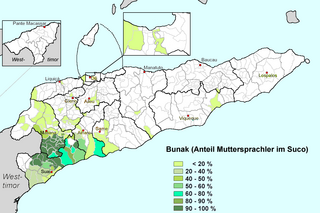Related Research Articles
Kuman is a language of Chimbu Province, Papua New Guinea. In 1994, it was estimated that 80,000 people spoke Kuman, 10,000 of them monolinguals; in the 2000 census, 115,000 were reported, with few monolinguals. Ethnologue also reported 70,000 second language speakers in 2021.

The Bunak language is the language of the Bunak people of the mountainous region of central Timor, split between the political boundary between West Timor, Indonesia, particularly in Lamaknen District and East Timor. It is one of the few on Timor which is not an Austronesian language, but rather a Papuan language of the Timor–Alor–Pantar language family. The language is surrounded by Malayo-Polynesian languages, like Uab Meto and Tetum.

Maʼya is an Austronesian language of the Raja Ampat islands in Southwest Papua, Indonesia. It is part of the South Halmahera–West New Guinea (SHWNG) subgroup and is spoken by about 6,000 people in coastal villages on the islands Misool, Salawati, and Waigeo, on the boundary between Austronesian and Papuan languages.
Bukawa is an Austronesian language of Papua New Guinea.
Sougb, or Sogh, is a Papuan language of the East Bird's Head language family spoken in the east of the Bird's Head Peninsula to the east of Meyah and to the south of Manokwari, including the area of Soug Jaya District, Teluk Wondama Regency. It consists of four dialects and is spoken by around 12,000 people in all. The language is alternatively known as Mantion, or Manikion, an originally derogatory term used by the Biak people.
The Kamoro language is an Asmat–Kamoro language spoken in Western New Guinea, specifically in Mimika Regency, Central Papua by approximately 8,000 people. Dialect diversity is notable, and Kamoro should perhaps not be considered a single language.
Kairiru is one of three Kairiru languages spoken mainly on Kairiru and Mushu islands and in several coastal villages on the mainland between Cape Karawop and Cape Samein near Wewak in East Sepik Province of Papua New Guinea.

Maʼya is an Austronesian language of the Raja Ampat islands in Southwest Papua, Indonesia. It is part of the South Halmahera–West New Guinea (SHWNG) subgroup and is spoken by about 6,000 people in coastal villages on the islands Misool, Salawati, and Waigeo, on the boundary between Austronesian and Papuan languages.
Jarawa is the most populous of the Bantu languages of northern Nigeria. It is a dialect cluster consisting of many varieties.
Kemberano is a Papuan language of the Bird's Head Peninsula of West Papua, Indonesia.
Boazi (Bwadji), also known as Kuni after one of its dialects, is a Papuan language spoken in the Western Province of Papua New Guinea by the Bwadji people in the vicinity of Lake Murray and is written using the Latin script, with ⟨æ⟩ for, ⟨ø⟩ for, and ⟨꞉⟩ for vowel length. Some recordings of songs and stories have been made in this language.
Orokaiva is a Papuan language spoken in the "tail" of Papua New Guinea.
Shiaxa (Sjiagha) and Yenimu, together known as South Awyu, are a Papuan language or languages of Papua, Indonesia. Whether they constitute one language or two depends on one's criteria for a 'language'. The two varieties are,
Yonggom is one of the Ok languages of Indonesia and Papua New Guinea. According to its speakers, it is part of a continuum of 9 mutually intelligible dialects of Muyu languages which also includes Muyu, North Muyu (Kadi), South Muyu, and Ningrum. Petabahasa by Indonesian Ministry of Education classified this language as Yonggom/Yongkom(BPS:1158 6) spoken in Kampung Ninati, although another name recorded for South Muyu(BPS:0917 2) is Yongon.
Kayan is a dialect cluster spoken by the Kayan people of Borneo. It is a cluster of closely related dialects with limited mutual intelligibility, and is itself part of the Kayan-Murik group of Austronesian languages.
Mumeng is a dialect chain of the Austronesian family in Morobe Province, Papua New Guinea. Dambi–Kumalu and Patep–Zenag–Gorakor have a degree of mutual intelligibility. Kapin may belong as well.
Mengen and Poeng are rather divergent dialects of an Austronesian language of New Britain in Papua New Guinea.
Ot Danum is a Barito language of the central Borneo, Indonesia, spoken by the Ot Danum people. Dialects include Cihie and Dohoi.
Bola, or Bakovi, is an Oceanic language of West New Britain in Papua New Guinea. The Harua (Xarua) dialect developed on a palm plantation.
Bunama is an Austronesian language spoken in the D'Entrecasteaux Islands of Papua New Guinea.
References
- ↑ Central Asmat at Ethnologue (18th ed., 2015) (subscription required)
Yaosakor Asmat at Ethnologue (18th ed., 2015) (subscription required) - ↑ Usher, Timothy; Suter, Edgar (2020). "The Asmat-Muli Languages of Southwestern New Guinea" (PDF). Language & Linguistics in Melanesia. 38. Port Moresby: Journal of the Linguistic Society of Papua New Guinea. ISSN 0023-1959.
- ↑ Voorhoeve, Clemens L. (1965). The Flamingo Bay Dialect of the Asmat Language. The Hague: M.Nijhoff.